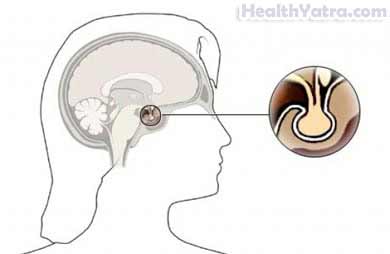সংজ্ঞা
The pituitary is a small complicated gland at the base of the brain. It makes several important hormones that regulate growth and the activity of several other major glands throughout the body. A pituitary adenoma is an abnormal growth, or tumor, in this gland. Pituitary adenomas are benign. This means they are not cancerous. They do not spread to other parts of the body. The growths can lead to visionproblems because it is near the eyes. It can also lead to growth problems. It often can also disrupt the hormonal balance of the thyroid, adrenal, and gonads.

কারণসমূহ
The cause is unknown. Some tumors are part of other endocrine disorders and are associated with genetic changes. These can be inherited.
Tumors can also be a result of exposure to cancer causing substances like radiation. In some cases the DNA changes may occur for no known reason.
ঝুঁকির কারণ
Factors that increase your chance of pituitary adenoma include:
- A family or personal history of multiple endocrine neoplasia, type 1 (MEN1) —a hereditary condition that increases the risk of developing pituitary, hypothalamus, and parathyroid and pancreatic tumors
- Other disorders that run in the family like Carney complex or acromegaly (giantism)
লক্ষণ
Symptoms can vary quite a bit and may not be present at all. It will depend on whether or not the tumor is secreting hormones and how large it is. The tumor’s location at the base of the brain can also cause symptoms.
General symptoms due to size may include:
- মাথাব্যথা
- Blurred vision or tunnel vision
In addition to the above, symptoms from Prolactin Secreting Adenoma (40% of all cases)
- Milk production from nonlactating females
- Loss of or irregular periods
- সেক্স ড্রাইভের ক্ষতি
- যোনি শুষ্কতা
- Low bone density or osteoporosis
Symptoms from Thyrotropin-secreting Adenoma
- Enlarged thyroid (eg goiter)
Symptoms of hyperthyroidism
- কম্পন
- হৃদস্পন্দন
- দুশ্চিন্তা
- ওজন কমানো
- অনিদ্রা
Symptoms from Corticotropin-secreting Adenoma:
- Menstrual disturbance
- উচ্চ্ রক্তচাপ
- High fasting glucose
- Skin changes (increased facial hair, acne, bruising, bluish stretch marks
- Buffalo hump (increased fatty tissue in back)
- Obesity especially around the wrist
- Round face
Growth Hormone-secreting Adenoma
- Acromegaly (adult)
- Gigantism (child)
- উচ্চ্ রক্তচাপ
- High fasting blood sugar
- Facial features coarse
- Oily skin
- Excess sweating
Pituitary adenomas may also be associated with the following conditions:
- ডায়াবেটিস মেলিটাস
- কিডনিতে পাথর
- হৃদরোগের
- উচ্চ্ রক্তচাপ
- অস্টিওপোরোসিস
- থাইরয়েড রোগ
রোগ নির্ণয়
Your doctor will ask about your symptoms and medical history. A physical exam will be done. You will be referred to an endocrinologist. This is a doctor that specialized on glands and hormones. Tests may include:
- Blood tests—to measure pituitary and other gland (prolactin, TSH, FT4, IGF-1, growth hormone, corticotrophin or ACTH, beta human gonadotropin, alpha subunit, estradiol, testosterone), hormone levels, blood sugar levels and to identify other underlying conditions that may be causing your symptoms
- Urine tests—to measure excretion levels of certain pituitary gland hormones (beta human gonadotropin, cortisol)
- Visual field tests—to check for problems with peripheral vision
- MRI scan —a test that uses strong magnets and radio waves to create pictures of the pituitary gland near the brain
Special Tests
- Glucose tolerance test—the standard test for acromegaly
- Dexamethasone suppression test and corticotropin-releasing hormone (CRH) test—best tests to see if excessive secretion of hormones from the adrenal gland is due to a pituitary adenoma
চিকিৎসা
Treatment depends on the presence and type of hormones being secreted. It is not uncommon for these treatment options to be used in combination. Talk with your doctor about the best plan for you.
চিকিত্সার বিকল্পগুলির মধ্যে রয়েছে:
সার্জারি
Surgery is often done to remove the tumor. The rest of the normal pituitary gland may be damaged during surgery. This can be treated by replacing the missing hormones with pills or other forms of hormone replacement.
ওষুধ
Medications can control symptoms and sometimes shrink the tumor. They can block hormone secretion.
For the majority of adenomas, that are prolactin or growth hormone secreting, medications may include:
- Dopamine agonists (eg cabergoline, bromocriptine)
- Octreotide or long-acting versions
বিকিরণ থেরাপির
Radiation therapy involves the use of radiation to kill tumor cells. The types of radiation therapy used to treat pituitary adenomas include:
- Conventional therapy—radiation is directed at the pituitary from a source outside the body
- Stereotactic radiosurgery—an intense radiation beam is targeted directly at the tumor
- Proton beam radiotherapy—a beam of protons (positively charged particles) is directly focused on the tumor
প্রতিরোধ
There are no guidelines for preventing a pituitary adenoma.
